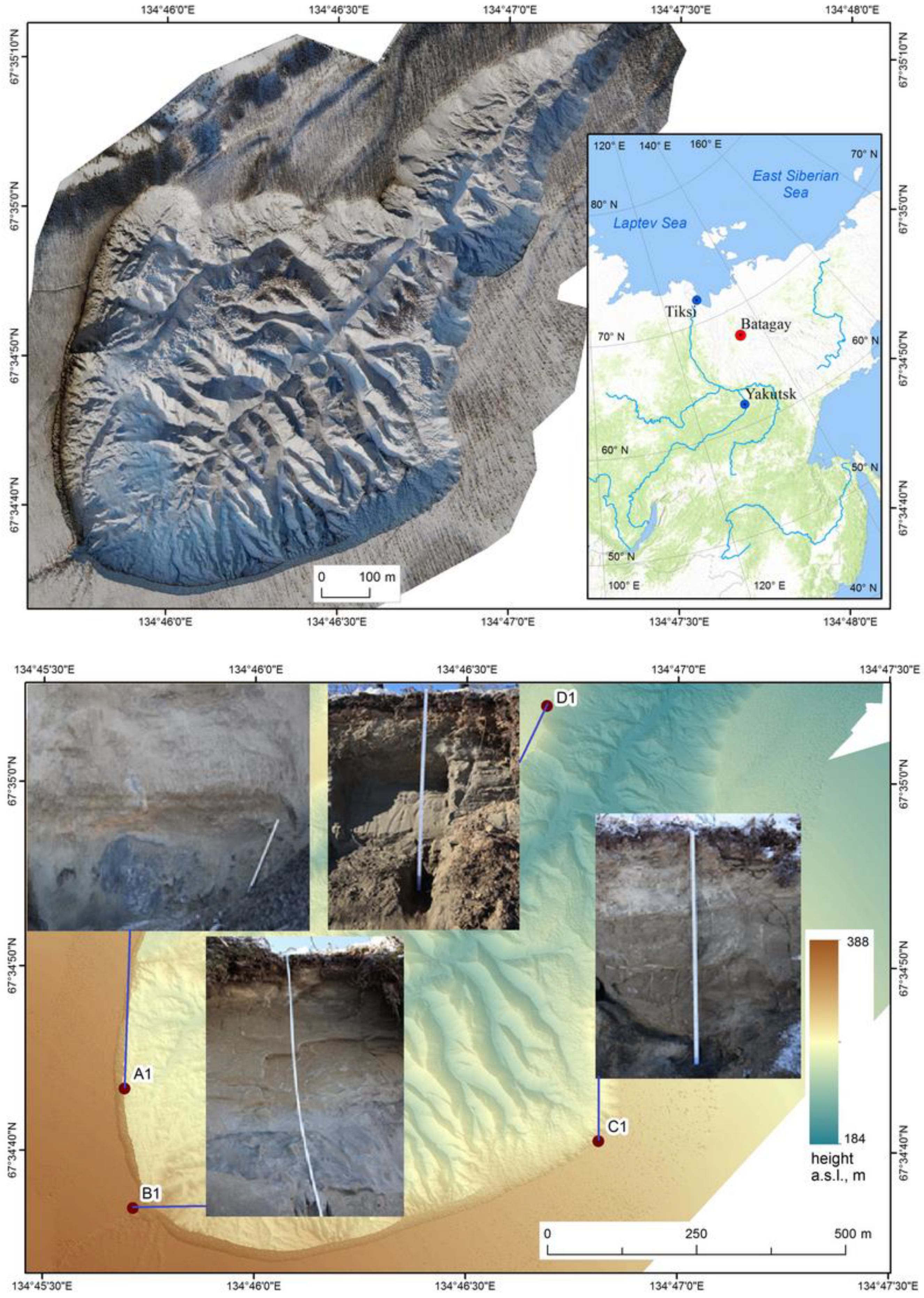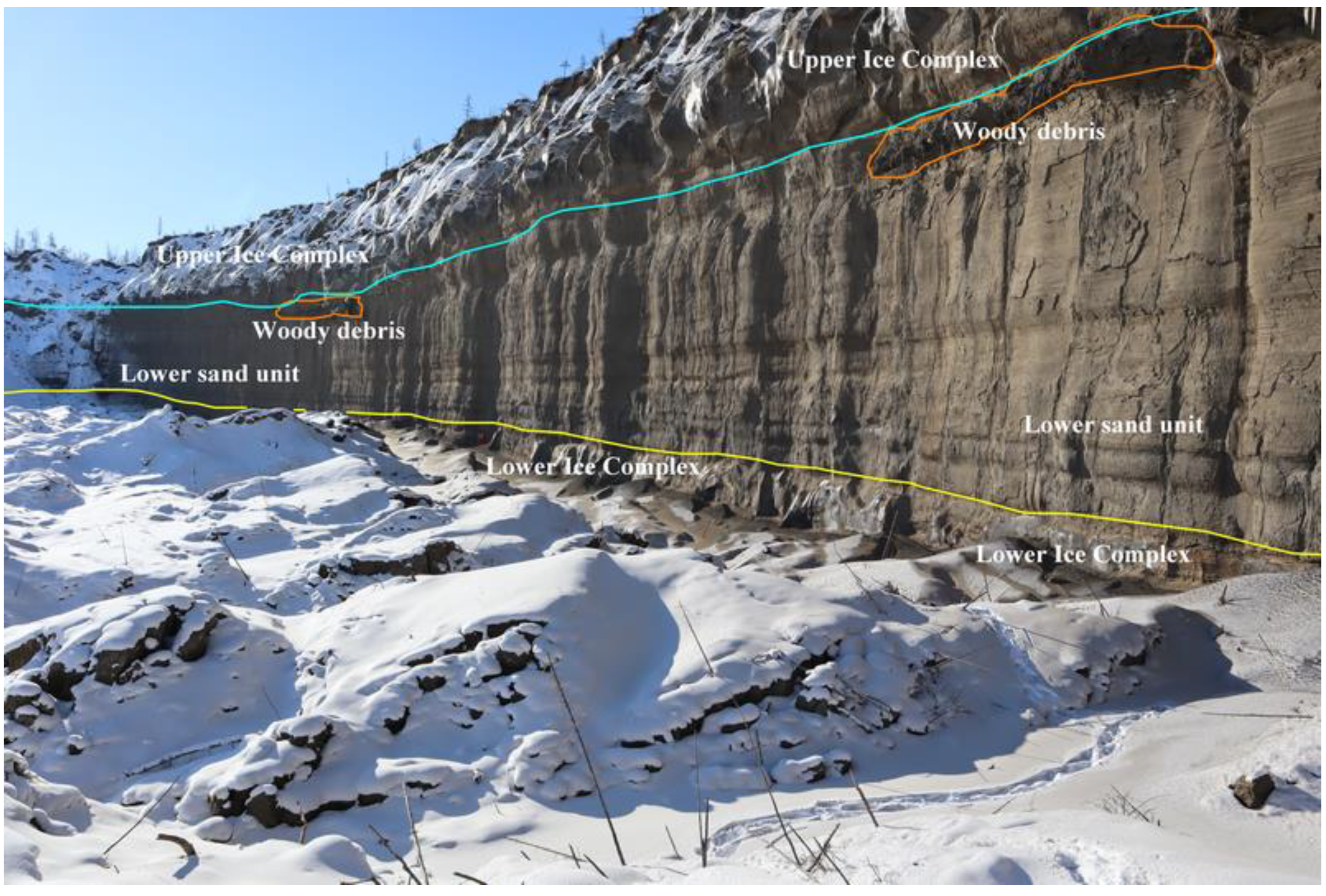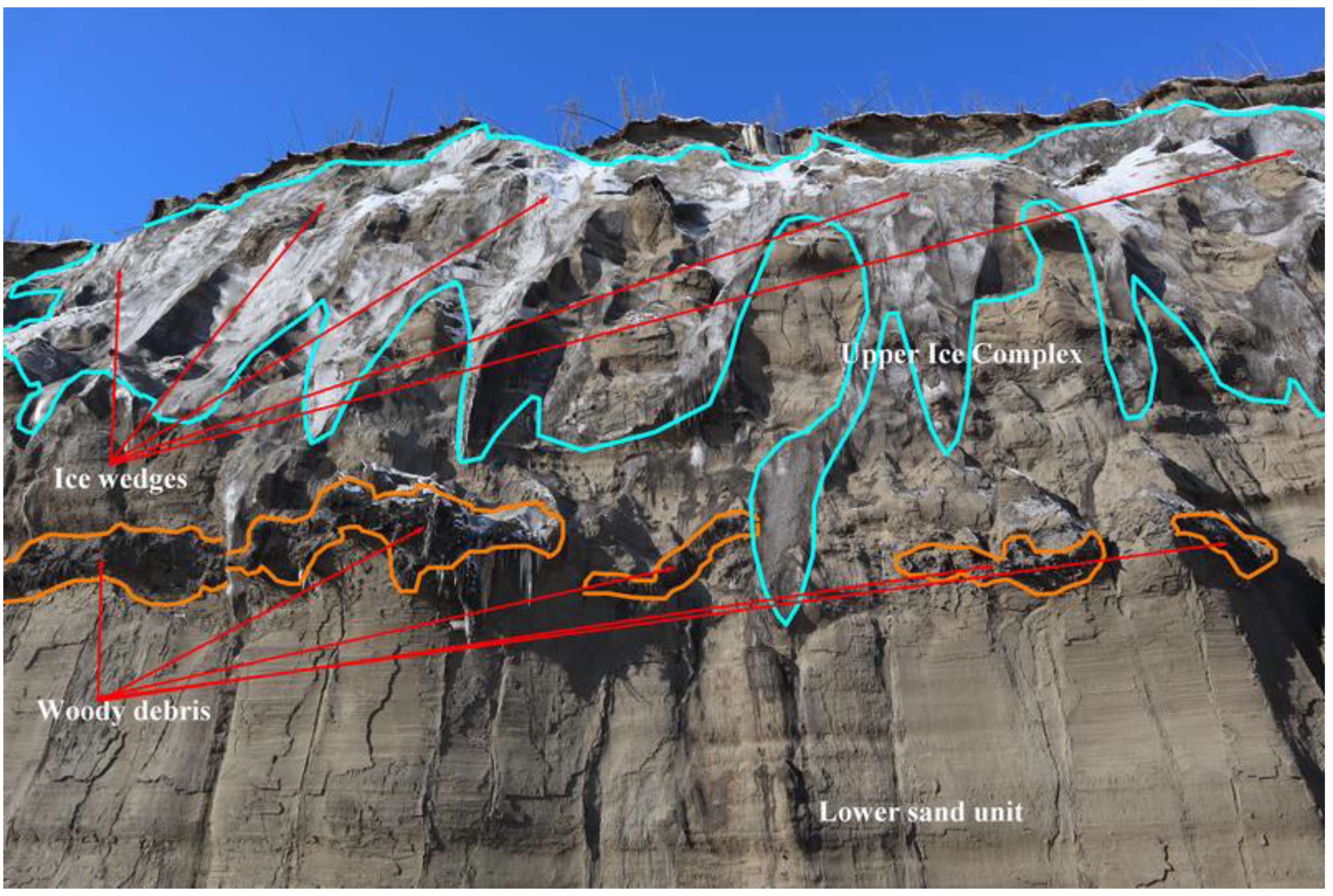Sub-Surface Carbon Stocks in Northern Taiga Landscapes Exposed in the Batagay Megaslump, Yana Upland, Yakutia
Abstract
:1. Introduction
2. Brief Natural Conditions of the Study Area
3. Materials and Methods
Terms Used in the Article
4. Results and Discussion
4.1. General Cryostratigraphy of Permafrost Exposed in the Batagay Megaslump
4.2. Carbon Stocks of the Lower and the Upper Ice Complex Units, and the Uppermost Cover
- (a)
- prolonged permafrost conditions of the territory with cryogenic and exogenous processes occurring in it;
- (b)
- the transfer of aeolian material and its accumulation;
- (c)
- the impact of the Quaternary climate and paleoclimate;
- (d)
- the movement and deformation as a result of the tectonic influence of the territory. That means the Adycha–Taryn general snap has or had an impact on the formation of the Batagay megaslump in conjunction with the other listed predictors. This is because the formation of such a large-scale current geocryological object in the North of Yakutia could not have taken place without the participation of intense seismotectonic conditions of the territory.
5. Conclusions
Author Contributions
Funding
Acknowledgments
Conflicts of Interest
References
- Kunitsky, V.V.; Syromyatnikov, I.I.; Schirrmeister, L.; Skachkov, Y.B.; Grosse, G.; Wetterich, S.; Grigoriev, M.N. Ice rocks and thermal denudation near Batagai (Yanskoye plateau, Eastern Siberia). Earth Cryosphere 2013, 17, 56–68. (In Russian) [Google Scholar]
- Günther, F.; Grosse, G.; Wetterich, S.; Jones, B.M.; Kunitsky, V.V.; Kienast, F.; Schirrmeister, L. The Batagay mega thaw slump, Yana Uplands, Yakutia, Russia: Permafrost thaw dynamics on decadal time scale. In Proceedings of the PAST Gateways—Palaeo-Arctic Spatial and Temporal Gateways: Third International Conference and Workshop, Potsdam, Germany, 18–22 May 2015; pp. 45–46. [Google Scholar]
- Vadakkedath, V.; Zawadzki, J.; Przezdziecki, K. Multisensory satellite observations of the expansion of the Batagaika crater and succession of vegetation in its interior from 1991 to 2018. Environ. Earth Sci. 2020, 79, 1–10. [Google Scholar] [CrossRef] [Green Version]
- Zhurlov, O.S.; Grudinin, D.A.; Yakovlev, I.G. Phylogenetic 16S metagenomic analysis and antibiotic resistance of psychrotolerant bacteria isolated from the soil of the Batagai failure. Int. J. Appl. Basic Res. 2015, 11, 648–651. (In Russian) [Google Scholar]
- Opel, T.; Murton, J.B.; Wetterich, S.; Meyer, H.; Ashastina, K.; Günther, F.; Grotheer, H.; Mollenhauer, G.; Danilov, P.P.; Boeskorov, V.; et al. Past climate and continentality inferred from ice wedges at Batagay megaslump in the Northern Hemisphere’s most continental region, Yana Highlands, interior Yakutia. Clim. Past 2019, 15, 1443–1461. [Google Scholar] [CrossRef] [Green Version]
- Murton, J.B.; Edwards, M.E.; Lozhkin, A.V.; Anderson, P.M.; Savvinov, G.N.; Bakulina, N.; Bondarenko, O.V.; Cherepanova, M.V.; Danilov, P.P.; Boeskorov, V.; et al. Preliminary paleoenvironmental analysis of permafrost deposits at Batagaika megaslump, Yana Uplands, northeast Siberia. Quat. Res. 2017, 87, 314–330. [Google Scholar] [CrossRef] [Green Version]
- Wetterich, S.; Murton, J.B.; Toms, P.; Wood, J.; Blinov, A.; Opel, T.; Fuchs, M.C.; Merchel, S.; Rugel, G.; Gärtner, A.; et al. Multi-method dating of ancient permafrost of the Batagay megaslump, East. Siberia. In Proceedings of the EGU General Assembly 2020, Lund, Sweden, 4–8 May 2020. EGU2020-2999, online. [Google Scholar]
- Kienast, F.; Ashastina, K.; Troeva, E. Phylogeography of a west-Beringian endemic plant: An ancient seed of Stellaria jacutica Schischk. detected in permafrost deposits of the last interglacial. Rev. Palaeobot. Palynol. 2018, 259, 48–54. [Google Scholar] [CrossRef]
- Melchinov, V.P.; Pavlov, A.A.; Kladkin, V.P.; Bashkuev, Y.B.; Haptanov, V.B. Radio wave diagnostics of ice rocks in the zone of thermokarst failure (Batagai, Yakutia). In Proceedings of the XXVI All-Russian Open Scientific Conference, Kazan, Russian, 1–6 July 2019; Kazan (Volga) Federal University Publishing House: Kazan, Russian, 2019; Volume 1, pp. 495–498. (In Russian). [Google Scholar]
- Vasilchuk, Y.K.; Vasilchuk, D.Y.; Budantseva, N.A.; Vasilchuk, A.K.; Trishin, A.Y. High-Resolution Oxygen Isotope and Deuterium Diagrams for Ice Wedges of the Batagai Yedoma, Northern Central Yakutia. Dokl. Earth Sci. 2019, 487, 986–989. [Google Scholar] [CrossRef]
- Vasilchuk, Y.K.; Vasilchuk, J.Y.; Budantseva, N.A.; Vasilchuk, A.C.; Trishin, A.Y. Isotopic and geochemical features of the Batagaika yedoma (preliminary results). Arct. Antarct. 2017, 3, 69–96. (In Russian) [Google Scholar]
- Ashastina, K.; Kuzmina, S.; Rudaya, N.; Troeva, E.; Schoch, W.; Römermann, C.; Reinecke, J.; Otte, V.; Savvinov, G.; Wesche, K.; et al. Woodlands and steppes: Pleistocene vegetation in Yakutia’s most continental part recorded in the Batagay permafrost sequence. Quat. Sci. Rev. 2018, 196, 38–61. [Google Scholar] [CrossRef]
- Fedorov, A.N.; Konstantinov, P.Y.; Vasilyev, N.F.; Shestakova, A.A. The influence of boreal forest dynamics on the current state of permafrost in Central Yakutia. Polar Sci. 2019, 22, 100483. [Google Scholar] [CrossRef]
- Knorre, A.A.; Kirdyanov, A.V.; Prokushkin, A.S.; Krusic, P.J.; Büntgen, U. Tree ring-based reconstruction of the long-terminfluence of wildfires on permafrost active layer dynamics in Central Siberia. Sci. Total Environ. 2019, 652, 314–319. [Google Scholar] [CrossRef] [PubMed] [Green Version]
- Karelin, D.V.; Zamolodchikov, D.G.; Gilmanov, T.G. Reserves and carbon production in the phytomass of tundra and forest-tundra ecosystems of Russia. Forestry 1995, 5, 29–36. (In Russian) [Google Scholar]
- Chestnykh, O.V.; Zamolodchikov, D.G.; Utkin, A.I. General reserves of bioremediation of carbon and nitrogen in the soil of the forest fund of Russia. Russ. For. Sci. 2004, 4, 30–42. (In Russian) [Google Scholar]
- Hugelius, G.; Strauss, J.; Zubrzycki, S.; Harden, J.W.; Schuur, E.A.G.; Ping, C.-L.; Schirrmeister, L.; Grosse, G.; Michaelson, G.J.; Koven, C.D.; et al. Estimated stocks of circumpolar permafrost carbon with quantified uncertainty ranges and identified data gaps. Biogeosciences 2014, 11, 6573–6593. [Google Scholar] [CrossRef] [Green Version]
- Schepashchenko, D.G.; Mukhortova, L.V.; Shvidenko, A.Z.; Vedrova, E.F. Reserves of organic carbon in the soils of Russia. Soil Sci. 2013, 2, 123–132. (In Russian) [Google Scholar]
- Schuur, E.A.G.; McGuire, A.D.; Schädel, C.; Grosse, G.; Harden, J.W.; Hayes, D.J.; Hugelius, G.; Koven, C.D.; Kuhry, P.; Lawrence, D.M.; et al. Climate change and the permafrost carbon feedback. Nature 2015, 520, 171–179. [Google Scholar] [CrossRef] [PubMed]
- Masyagina, O.V.; Menyailo, O.V. The impact of permafrost on carbon dioxide and methane fluxes in Siberia: A meta-analysis. Environ. Res. 2020, 182, 109096. [Google Scholar] [CrossRef]
- Dao, T.T.; Gentsch, N.; Mikutta, R.; Sauheitl, L.; Shibistova, O.; Wild, B.; Schnecker, J.; Bárta, J.; Čapek, P.; Gittel, A.; et al. The fate of carbohydrates and lignin in north-east Siberian permafrost soils. Soil Biol. Biochem. 2018, 116, 311–322. [Google Scholar] [CrossRef]
- Bjorkman, A.; Myers-Smith, I.H.; Elmendorf, S.C.; Normand, S.; Rüger, N.; Beck, P.S.A.; Blach-Overgaard, A.; Blok, D.; Cornelissen, J.H.C.; Forbes, B.C.; et al. Plant functional trait change across a warming tundra biome. Nature 2018, 562, 57–62. [Google Scholar] [CrossRef]
- Douglas, T.A.; Turetsky, M.R.; Koven, C.D. Increased rainfall stimulates permafrost thaw across a variety of Interior Alaskan boreal ecosystems. Npj Clim. Atmos. Sci. 2020, 3, 1–7. [Google Scholar] [CrossRef]
- Isachenko, A.G. Landscapes of the USSR; Leningrad University Publishing House: Leningrad, Russia, 1985; 320p. (In Russian) [Google Scholar]
- Danilov, I.D. The permafrost zone of the Earth and its zoning. Bull. USSR Acad. Sci. Geogr. Ser. 1983, 1, 12–18. (In Russian) [Google Scholar]
- The Geography of Siberia at the Beginning of the XXI Century: Eastern Siberia; Korytny, L.M.; Tulokhonov, A.K. (Eds.) Geo Publishing House: Novosibirsk, Russia, 2016; Volume 6, 396p. (In Russian) [Google Scholar]
- Imaev, V.S.; Imaeva, L.P.; Kozmin, B.M. Seismotectonics of Yakutia; GEOS Publishing House: Moscow, Russia, 2000; 227p. (In Russian) [Google Scholar]
- Ershov, E.D. General Geocryology; Moscow State University Publishing House: Moscow, Russia, 2002; 683p. (In Russian) [Google Scholar]
- Baulin, V.V.; Dubikov, G.I.; Aksenov, V.I.; Koreisha, M.M.; Murzaev, V.A.; Poznanin, V.L.; Rivkin, F.M. Geocryological Glossary; GEOS Publishing House: Moscow, Russia, 2003; 140p. (In Russian) [Google Scholar]
- Vadyunina, A.F.; Korchagina, Z.A. Methods for Studying the Physical Properties of Soils; Agropromizdat Publishing House: Moscow, Russia, 1986; 416p. (In Russian) [Google Scholar]
- Trofimov, V.T.; Balykova, S.D.; Bolikhovskaya, N.S.; Andreeva, T.V.; Alekseev, B.A.; Bolikhovsky, V.F.; Dodonov, A.E.; Ermakov, Y.G.; Ershova, A.V.; Kadyrov, E.V.; et al. Loess Mantle of the Earth and its Properties; Moscow State University Publishing House: Moscow, Russia, 2001; 464p. (In Russian) [Google Scholar]
- Shur, Y.L. Thermokarst; Nedra Publishing House: Moscow, Russia, 1977; 80p. (In Russian) [Google Scholar]
- Ganzhara, N.F.; Borisov, B.A.; Baibekov, R.F. Workshop on Soils Study; Agrokonsalt Publ.: Moscow, Russia, 2002; 280p. (In Russian) [Google Scholar]
- Krylenkov, V.A.; Goncharov, A.E. Microbiota of the Terrestrial Cryosphere; Foliant Publishing House: St. Petersburg, Russia, 2019; 448p. (In Russian) [Google Scholar]
- Vincent, W.F. Microbial ecosystem responses to rapid climate change in the Arctic. Int. Soc. Microb. Ecol. 2010, 4, 1087–1090. [Google Scholar] [CrossRef] [PubMed] [Green Version]
- Graham, D.E.; Wallenstein, M.D.; Vishnivetskaya, T.A.; Waldrop, M.P.; Phelps, T.J.; Pfiffner, S.M.; Onstott, T.C.; Whyte, L.G.; Rivkina, E.M.; Gilichinsky, D.A.; et al. Microbes in thawing permafrost: The unknown variable in the climate change equation. Int. Soc. Microb. Ecol. 2012, 6, 709–712. [Google Scholar] [CrossRef] [PubMed]
- Nikrad, M.P.; Kerkhof, L.J.; Häggblom, M.M. The subzero microbiome: Microbial activity in frozen and thawing soils. FEMS Microbiol. Ecol. 2016, 92, fiw081. [Google Scholar] [CrossRef] [PubMed]
- Bazilevich, N.I. Biological Productivity of Ecosystems of Northern Eurasia; Nauka Publishing House: Moscow, Russia, 1993; 293p. (In Russian) [Google Scholar]
- Ashastina, K.; Schirrmeister, L.; Fuchs, M.; Kienast, F. Palaeoclimate characteristics in interior Siberia of MIS 6-2: First insights from the Batagay permafrost mega-thaw slump in the Yana Highlands. Clim. Past 2017, 13, 795–818. [Google Scholar] [CrossRef] [Green Version]
- Prokushkin, A.S.; Hagedorn, F.; Pokrovsky, O.S.; Viers, J.; Kirdyanov, A.V.; Masyagina, O.V.; Prokushkina, M.P.; McDowell, W.H. Permafrost regime affects the nutritional status and productivity of larches in Central Siberia. Forests 2018, 9, 314. [Google Scholar] [CrossRef] [Green Version]
- Shpedt, A.A.; Ligaeva, N.A.; Emelyanov, D.V. Transformation of soil and land resources of the Middle Siberia in the conditions of climatic changes. In Proceedings of the IOP Conference Series: Earth and Environmental Science, Krasnoyarsk, Russian, 20–22 June 2019; Volume 315, p. 052051. (In Russian). [Google Scholar]



| Sampled Units | Description of Selected Profile Sections |
|---|---|
| A1. Lower Ice Complex, southern exposure: 67°34′43.35″ N 134°45′41.58″ E | At the top there are light brown layers of loess with streaks of organic residues and hanging thin root. Single inclusions of coal are present. The width of the interlayers varies from 0.15 to 0.35 m. At the height of 1.5–1.7 m from the bottom of the slump, there is a strip of gravel of 1.2 m long. The size of the gravel varies from 3 mm to 3.5 cm. The profile is homogeneous; it is composed of sandy loam (sandy and dusty particles) of a dark gray color. The horizon is riddled with rare roots. There are inclusions of charred wood residues—small inclusions of brown decomposed organic matter. To the right of the sampling site, at a distance of 1.6 m and a height of 1.5 m, there is a light-brown interlayer with an orange tint of about 2.1 m long and 0.4 m wide. Its structure consists of small lumps with a diameter of 0.1–0.5 mm. Spots of black coal and thin roots are observed. In some sections, the material contains alternating ice schlieren. It has a conditional ataxic cryostructure. Above the interlayer, dark gray sand contains many roots. |
| B1. Upper Ice Complex, southern exposure: 67°34′36.87″ N 134°45′42.84″ E | Section from top to bottom at the edge of the wall: (O) 0.0–0.04 m—forest litter (mosses, lingonberries, needles, rags). (A) 0.04–0.14 m—humus horizon. 0.14–0.25 (0.30) m—light brown sandy loam with inclusions of coal, strongly penetrated by roots. 0.25 (0.30)–1.2 m—dark gray sandy loam, transition to the next horizon is clear, the border is even. The horizon contains many thin roots. The texture of the horizon is homogenous, with the exception of crushed stone inclusions at a depth of 0.8 m. 1.2–1.5 m—gray sandy loam with a whitish tint, a row of gravel separately located at a distance of 0.04 to 0.1 m, diameter from 0.002 to 0.01 m. 1.5 m—permafrost of the upper Ice Complex. |
| C1. Upper Sand, northern exposure: 67°34′40.58″ N 134°46′48.86″ E | Section from top to bottom from the edge of the wall: (O) 0.0–0.03 m—forest litter (mosses, lingonberries, needles and rags). (A) 0.03–0.08 m—dark brown humus horizon. 0.08–0.39 m—loam of light brown color, containing many roots. The transition to the next horizon is noticeable, the border is even, there were inclusions of pebbles with a diameter of 70–90 mm. 0.39–1.01 m—dark brown sandy loam. At a depth of 0.39–0.53 m, a large accumulation of roots from 0.53 m. At a depth of 0.74 m, there are holes with a diameter of 2 cm. The texture of the horizon is homogeneous. |
| D1. Ravine, southern exposure: 67°35′04.16″ N 134°46′41.34″ E | Section from top to bottom from the edge of the wall: (O) 0.0–0.02 m—forest litter (leaves, needles, rags). (A) 0.02–0.09 m—dark brown humus horizon, roots of different diameters abundant. 0.09–0.29 m—silt sandy loam of light brown color strongly penetrated by roots. The transition to the next horizon is subtle, the border is smooth. 0.29–1.0 m—gray sandy loam, rare thin roots, the horizon is homogeneous. |
| B1. Upper Ice Complex. Southern Exposure of The Slump | ||||
|---|---|---|---|---|
| Index | Unit | OC, % | IC, % | TC, % |
| min | Active layer | 0.27 | 0.06 | 0.36 |
| max | 12.49 | 0.59 | 13.07 | |
| mean | 3.50 | 0.23 | 3.74 | |
| SD | 1.62 | 0.08 | 1.70 | |
| min | Shielding layer | 0.26 | 0.09 | 0.36 |
| max | 0.27 | 0.11 | 0.38 | |
| mean | 0.27 | 0.10 | 0.37 | |
| SD | 0.01 | 0.01 | 0.01 | |
| min | Upper Ice Complex(permafrost) | 0.71 | 0.21 | 0.92 |
| max | 1.38 | 0.23 | 1.60 | |
| mean | 1.04 | 0.22 | 1.25 | |
| SD | 0.14 | 0.01 | 0.14 | |
| A1. Lower Ice Complex. Southern Exposure of The Slump | ||||
| min | Lower Ice Complex(permafrost) | 0.52 | 0.14 | 0.68 |
| max | 0.89 | 0.20 | 1.08 | |
| mean | 0.65 | 0.17 | 0.82 | |
| SD | 0.03 | 0.01 | 0.03 | |
| C1. Upper Ice Complex. Northern Exposure of The Slump | ||||
| min | Active layer | 0.34 | 0.08 | 0.45 |
| max | 6.85 | 0.32 | 7.13 | |
| mean | 2.05 | 0.15 | 2.20 | |
| SD | 0.79 | 0.03 | 0.81 | |
| D1. Ravine. Southern Exposure of The Slump | ||||
| min | Active layer | 0.27 | 0.10 | 0.38 |
| max | 8.98 | 0.30 | 9.28 | |
| mean | 2.77 | 0.16 | 2.92 | |
| SD | 0.98 | 0.02 | 1.00 | |
| B1. Upper Ice Complex. Southern Exposure of The Slump | |||||
|---|---|---|---|---|---|
| Depth, m | Unit | Density, g cm−3 | OC, kg m−2 | IC, kg m−2 | TC, kg m−2 |
| 0.04–0.14 | Active layer | 1.15 | 11.23 | 0.63 | 11.86 |
| 0.14–0.25(0.30) | 1.65 | 1.25 | 0.16 | 1.41 | |
| 0.25(0.30)–1.2 | 1.65 | 4.03 | 1.42 | 5.45 | |
| Total | 16.51 | 2.21 | 18.72 | ||
| SD | 0.82 | 0.18 | 0.90 | ||
| 1.2–1.5 | Shielding layer | 1.65 | 1.31 | 0.50 | 1.81 |
| SD | 0.01 | 0.02 | 0.03 | ||
| 1.5–2.0 | Upper Ice Complex (permafrost) | 1.65 | 8.53 | 1.81 | 10.34 |
| SD | 1.13 | 0.03 | 1.12 | ||
| Total | 26.35 | 4.52 | 30.87 | ||
| SD | 1.02 | 0.16 | 1.11 | ||
| A1. Lower Ice Complex. Southern Exposure of The Slump | |||||
| 58.4–58.8 | Lower Ice Complex (permafrost) | 1.70 | 1.08 | 0.26 | 1.34 |
| 58.8–59.1 | 1.70 | 3.27 | 0.76 | 4.03 | |
| 59.1–59.6 | 1.70 | 2.70 | 0.96 | 3.66 | |
| 59.6–59.6 | 1.70 | 7.03 | 1.60 | 8.63 | |
| Total | 14.08 | 3.58 | 17.66 | ||
| SD | 0.58 | 0.13 | 0.71 | ||
| C1. Upper Ice Complex. Southern exposure of the slump | |||||
| 0.0–0.03 | Active layer | 1.15 | 2.26 | 0.10 | 2.36 |
| 0.03–0.08 | 1.15 | 0.70 | 0.07 | 0.77 | |
| 0.08–0,39 | 1.65 | 1.81 | 0.54 | 2.35 | |
| 0.39–1.01 | 1.65 | 4.75 | 1.26 | 6.01 | |
| Total | 9.52 | 1.97 | 11.49 | ||
| SD | 0.45 | 0.15 | 0.58 | ||
| D1. Ravine. Northern exposure of the slump | |||||
| 0.02–0.09 | Active layer | 1.15 | 6.65 | 0.21 | 6.86 |
| 0.09–0.29 | 1.65 | 6.51 | 0.40 | 6.92 | |
| 0.29–1.0 | 1.65 | 4.87 | 1.36 | 6.23 | |
| Total | 18.03 | 1.97 | 20.01 | ||
| SD | 0.44 | 0.17 | 0.38 | ||
© 2020 by the authors. Licensee MDPI, Basel, Switzerland. This article is an open access article distributed under the terms and conditions of the Creative Commons Attribution (CC BY) license (http://creativecommons.org/licenses/by/4.0/).
Share and Cite
Shepelev, A.G.; Kizyakov, A.; Wetterich, S.; Cherepanova, A.; Fedorov, A.; Syromyatnikov, I.; Savvinov, G. Sub-Surface Carbon Stocks in Northern Taiga Landscapes Exposed in the Batagay Megaslump, Yana Upland, Yakutia. Land 2020, 9, 305. https://doi.org/10.3390/land9090305
Shepelev AG, Kizyakov A, Wetterich S, Cherepanova A, Fedorov A, Syromyatnikov I, Savvinov G. Sub-Surface Carbon Stocks in Northern Taiga Landscapes Exposed in the Batagay Megaslump, Yana Upland, Yakutia. Land. 2020; 9(9):305. https://doi.org/10.3390/land9090305
Chicago/Turabian StyleShepelev, Andrei G., Alexander Kizyakov, Sebastian Wetterich, Alexandra Cherepanova, Alexander Fedorov, Igor Syromyatnikov, and Grigoriy Savvinov. 2020. "Sub-Surface Carbon Stocks in Northern Taiga Landscapes Exposed in the Batagay Megaslump, Yana Upland, Yakutia" Land 9, no. 9: 305. https://doi.org/10.3390/land9090305







